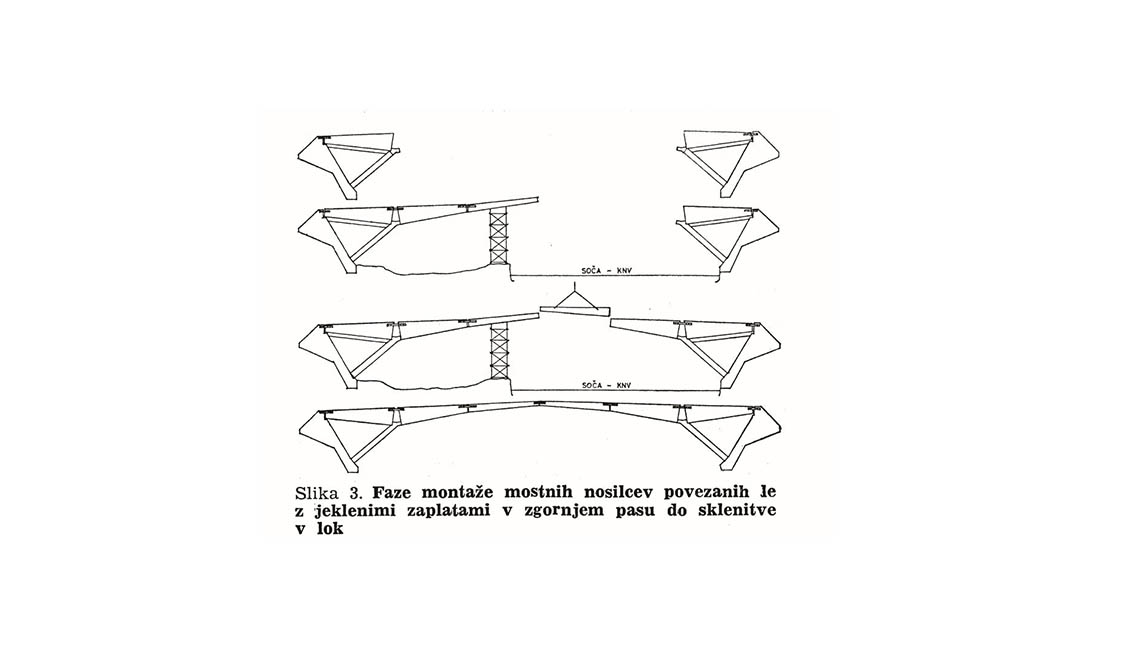descla

Deskle Road Bridge
Gorazd HUMAR
HISTORY
AN ENGINEERING ACHIEVEMENT MARKED BY INNOVATION AND TECHNICAL EXCELLENCE
For many years, the village of Deskle (Descla), which grew substantially due to the Anhovo cement factory, relied on a simple pedestrian suspension bridge—supported by two steel cables—to connect the riverbanks. When the footbridge deteriorated and no longer met safety standards, the community took decisive action, commissioning a new bridge engineered to accommodate both pedestrians and vehicles weighing up to two metric tons.The design presented considerable technical challenges. The selected site along the Soča-Isonzo River featured intense currents, with water levels reaching 12 metres. These conditions made it impossible to place piers within the riverbed, leading the engineering team to opt for an arch bridge design with abutments positioned beyond the reach of peak water levels. However, this solution presented its own difficulties, as arch bridge construction typically requires scaffolding. To overcome this, the engineering team resorted to prefabricated reinforced concrete elements that could be installed using a high-capacity mobile crane. This bold approach initially faced resistance from all the reviewers in Slovenia—but the team sought verification from two leading Yugoslavian experts of the time, who were concurrently overseeing the construction of the Krk (Veglia) arch bridge.



BRIDGE CONSTRUCTION AND STRUCTURAL ENGINEERING
The construction of the 63-metre bridge used precast reinforced concrete elements that exceeded the strength standards of the time. The central section featured a 42-metre two-hinged arch, rising only 3 meters in height. The bridge spanned 7 metres in width, including a 4.5-metre roadway.The arch’s structural composition featured beams with a slender profile and tall vertical dimension. These components were subsequently joined into a single structural element by utilising reinforced concrete. The primary challenge lay in gradually assembling the arch’s load-bearing elements. Due to their substantial weight and the distances involved, the project required a powerful crane, which was not available in Slovenia at the time. A 170-ton capacity crane was brought from Italy to position all the prefabricated elements directly from the Soča-Isonzo River banks. During assembly, the arch’s prefabricated cantilever beams were temporarily secured only by steel plates at their tops. The crane needed to be repositioned just once to complete assembly on the river’s right bank. Once all the arch elements were in place, the structure was unified into a single block with reinforced concrete connections.
The arch assembly was completed in just three days, drawing crowds of locals who gathered to watch the impressive installation. Construction experts from across Slovenia visited to witness this groundbreaking project—never before had a bridge in Slovenia been constructed with such innovative engineering. To the delight of local residents and neighbouring communities, the bridge opened to traffic merely two months after assembly completion.
Despite initial challenges and significant scepticism from technical experts, the bridge proved to be an extraordinary success. Its elegant structure now enhances the Deskle riverscape.
BRIDGE CONSTRUCTION AND STRUCTURAL ENGINEERING
The construction of the 63-metre bridge used precast reinforced concrete elements that exceeded the strength standards of the time. The central section featured a 42-metre two-hinged arch, rising only 3 meters in height. The bridge spanned 7 metres in width, including a 4.5-metre roadway.The arch’s structural composition featured beams with a slender profile and tall vertical dimension. These components were subsequently joined into a single structural element by utilising reinforced concrete. The primary challenge lay in gradually assembling the arch’s load-bearing elements. Due to their substantial weight and the distances involved, the project required a powerful crane, which was not available in Slovenia at the time. A 170-ton capacity crane was brought from Italy to position all the prefabricated elements directly from the Soča-Isonzo River banks. During assembly, the arch’s prefabricated cantilever beams were temporarily secured only by steel plates at their tops. The crane needed to be repositioned just once to complete assembly on the river’s right bank. Once all the arch elements were in place, the structure was unified into a single block with reinforced concrete connections.
The arch assembly was completed in just three days, drawing crowds of locals who gathered to watch the impressive installation. Construction experts from across Slovenia visited to witness this groundbreaking project—never before had a bridge in Slovenia been constructed with such innovative engineering. To the delight of local residents and neighbouring communities, the bridge opened to traffic merely two months after assembly completion.
Despite initial challenges and significant scepticism from technical experts, the bridge proved to be an extraordinary success. Its elegant structure now enhances the Deskle riverscape.





